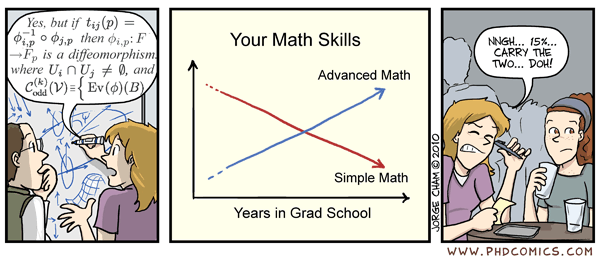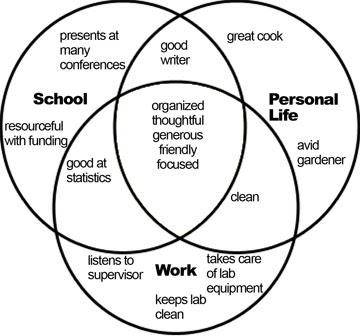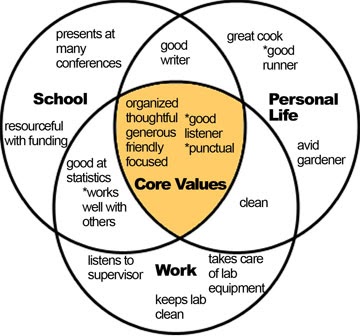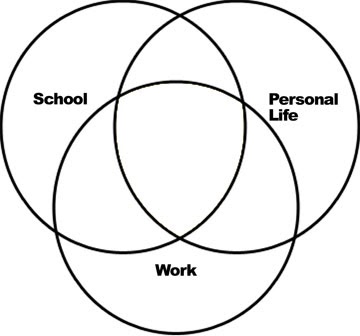Apply our problem solving method
Career Wise Menu
Learn problem solving skills: Build On Your Strengths

- Learn how to identify your strengths.
- Learn how to build upon the strengths you have and the ones you want to develop.
“How will I ever finish graduate school if I’m having so much trouble in my first year?”
“I’ve always wanted to go into an industry job, but all my training is for an academic position. How will I be able to be competitive on the job market if I don’t have those skills?”
“Both Dr. Lin and Dr. Williams have given me positive feedback about my writing this week. I’ve never considered myself a strong writer, but after re-reading my proposal, maybe I should give myself more credit.”
“I just started taking piano lessons again for the first time since I was a kid, and I love it! Strengthening skills unrelated to academics and my career is a great stress-reliever.”
People have the tendency to ruminate on the things that they dislike about themselves or view as weaknesses. Graduate students may experience academic or personal insecurities, particularly when comparing themselves to peers they perceive as more skilled than them.
However, every individual has within them a wealth of talents and resources, otherwise known as strengths, that can be used to obtain growth, success, and other positive outcomes. In fact, positive psychologists state that identifying and capitalizing on strengths is more likely to lead to success than putting energy into remedying perceived areas of weakness.
This module aims to guide you in identifying your strengths and putting them to use. By building on your strengths, you may feel more empowered to solve problems you encounter within your doctoral program and ultimately thrive as a woman in STEM.
Most people receive positive feedback on certain things they do, like when someone gets a good grade or is the computer whiz all the relatives ask for technical help. But people have many more strengths than the outside world knows or appreciates. The tricky part is appropriately identifying what they are and capitalizing on your skill set.
For instance, someone may know they are a good mathematician but not be aware they also are a great creative writer. This is most likely because they have had plenty of experience with solving equations and little exposure to writing poetry.
While creative writing may not be directly related to a STEM doctoral degree, it is important to identify strengths that help us enjoy many aspects of life, not just those that allow us to be successful in an academic setting.
By identifying your strengths, you are developing strengths knowledge (i.e., awareness and recognition of your strengths). The following statements can help you assess your strengths knowledge (Govindji & Linley, 2007, p. 147):
- Other people see the strengths I have.
- I know what I do best.
- I am aware of my strengths.
- I know the things I am good at doing.
- I know my strengths well.
- I know the things I do best.
- I know when I am at my best.
If you answered yes to these questions, you likely have a high level of awareness of your strengths. If these statements do not resonate with you, you may be unsure about your strong suits.
As you read through this module, you’ll learn a variety of ways you can assess your strengths. Gaining this understanding of “what’s right” about you is important, as strengths knowledge predicts strengths use (Allan et al., 2021).
There are several prominent ways of conceptualizing strengths. For example, in the Gallup Model, scholars describe strengths as talents that are well developed and produce excellence (Louis & Lopez, 2014). Talents include thought, feeling, or behavioral patterns that individuals use to achieve success.
These talents are believed to be naturally occurring, and people often use them unconsciously without their knowledge. The Gallup Model consists of 34 “talent themes” (Gallup, 2020). Here are some examples:
- Analytical
- Learner
- Empathy
- Positivity
- Communication
- Achiever
- Focus
Strengths are not merely talent- or skill-based. They comprise the full spectrum of human behavior, taking into account how we interact with the world around us, at work, at home, within a community, and as members of a larger society.
It is the amalgam of different kinds of strengths that gets someone to their desired goal. It may be an unacknowledged strength that gets you through difficult situations.
Below you will find examples from the Values in Action conceptualization of strengths. This model defines strengths as virtues, or elements of character (Peterson & Seligman, 2004).
| Characteristics | Strength Classification | Expression of Strength |
|---|---|---|
| Wisdom and Knowledge | Cognitive Strengths | Acquire and use different forms of knowledge |
| Courage | Emotional Strengths | Willfully accomplish goals under any circumstance |
| Love | Interpersonal Strengths | Cultivate relationships |
| Justice | Civic Strengths | Assist in creating healthy communities by being a fair and responsible leader |
| Temperance | Strengths that Prevent Excess | Forgive, be humble and thoughtful of one’s actions |
| Transcendence | Strengths that Create Connections to the Larger Universe | Be hopeful and appreciative of everyday existence |
If you are struggling to write up your experiment, you may think your difficulty with statistics is the linchpin. However, it may be your tenacity that gets you through and determines how successful you are, more than your basic understanding of the material.
Personal strengths of self-control and perseverance outweigh subject-matter acumen. If you are tenacious and ask for help, diligently do more reading, and seek feedback, you can tackle not just your challenging paper but many other (possibly more important) life issues.
Additionally, certain strengths are particularly powerful in making progress in graduate school and careers. For example, cognitive strengths in the realm of wisdom include innovative and productive thinking, curiosity, openness to experience, and love of learning.
Further, women tend to excel in relational strengths, those having to do with compassion, cooperation, empathy, nurturance, and communication. Choosing to emphasize and build on your personal assets is a far more promising path to feeling satisfied and successful than worrying about any deficits you might have in a problematic situation.
Self-test
Which statement reflects the “Courage” strength?
- A. I always try to mediate conflicts among my labmates. They can never seem to agree on things. I often find myself making the hard decisions for our team, after taking their thoughts into consideration.
- B. My colleague put his name first on our last paper, even though he knows I did the majority of the writing and analysis. Still, I’m not going to do the same to him with our upcoming proposal; he did the majority of work while I was out on maternity leave.
- C. I look forward to each semester and the classes I take because I love learning new things.
- D. Even when the lab equipment broke and the samples we received were spoiled, I still got the experiment done by the deadline.
People are also very comparison-based. Maybe you are not Marie Curie, but that doesn’t mean you’re not a good scientist. Be careful about comparing yourself to someone else when determining your strengths. This happens quite frequently within everyday life.
If your roommate who is a year behind you in your program has already taken and passed her comps, you might be tempted to think she’s more capable, smarter, or more successful than you are. However, other people's strengths are not your yardstick. You have your own strengths, and you are the best judge of them.
When you compare yourself to others, you may be living with a fixed mindset. When you have a fixed mindset, you may become stuck on perceived setbacks or failures. You may believe that your challenges are due to innate weaknesses.
If you experience this, it may be helpful to develop a growth mindset. Individuals with a growth mindset believe that they can grow and enhance their strengths through hard work and effort (Dweck & Liggitt, 1988).
When identifying your strengths, it’s important to focus on what’s right about you and what makes your life good in a variety of aspects, apart from the experiences of others. You may be a great mathematician, but you may also be creative and a good friend.
You utilize different strengths at different times in your life. It’s like using different muscles to rock climb versus cycling. People develop their strengths through their different unique life experiences.
Often we don’t think of these positive attributes as overlapping. It takes some reflection and a bit of self-dialogue. How have you dealt with challenges in the past? Often people’s toughest moments serve as pivotal life lessons and character builders.
Drawing from your past experiences can be very helpful. Ask yourself:
- What stressful events have I been through before?
- How did I deal with those?
- Who helped me? Or who did I think of at those moments?
- What did I learn about myself?
- Did it help to assist others in similar situations?
- How have I maintained hope for the future?
Let’s take an example of how one student reflected:
“Gosh, I dealt with that house fire a whole lot better than I’m taking getting my proposal rejected. I lost almost everything in that fire. OK, what did I do during that time? I called my mom, and even though it was 5 a.m. in Thailand she spoke to me for 2 hours.
“I thought of how she had survived that terrible tsunami while my sister and I were in the States. I remember refocusing on the positive things, like the fact that I had renter’s insurance and that I had a great labmate who let me stay with her until I found a new place.
“I learned that I have a great support system and that I’m not as attached to material possessions as I might have thought. There is a lot I can live without. If I can get through that, I’m not going to worry too much about things that aren’t life threatening. I can handle things that are within my control. Wow, I’ve been through much worse than a proposal rejection.”
Reflecting on past experiences allows you to recognize your resilience, or your capacity to cope with stress and succeed in the face of adversity. Your ability to withstand life's challenges is a strength within itself that will help you succeed in your doctoral program.
Once you have reminded yourself of your many strengths, it’s time to put them down on paper. You can create an asset map where you write down your personal assets and place them in the different domains of your life.
This idea originally came from community-building strategies, but it can also be used on the individual level. It’s a personal inventory of your strengths.
This inventory is different from defining how you want things to be or what you need to change. Asset mapping is acknowledging what you already have and focusing on your effectiveness.
It’s an empowerment strategy that draws on your already deep pool of skills. The idea is that you have what you need to be successful; it just needs some development.
Start with three overlapping circles in a Venn diagram and choose three or four areas in your life that are the most important. Let’s use School, Work, and Personal life as an example.
Then start placing your assets on your map. Does “great cook” go in the Work circle or just in Personal Life? “Makes people laugh” can probably go in all three, so it’s placed where all the circles overlap.
Ideally, you’ll have a lot of attributes in the center of your Venn diagram. These are your core strengths that: 1) serve many purposes, 2) enhance multiple areas of your life, and 3) are most central to you. You probably feel like you are best at these things because they seem to come up the most for you.

Now it’s time to stretch. Really think about your strengths in each distinct domain of your life. You may actually be a thoughtful romantic, but you have so little time to nurture your relationship with your partner that they are often getting the least of what you can offer.
Rather than label this a weakness, view it as a strength that needs more development. So, include those well-intended strengths that you may need to brush up on or pay more attention to. You can mark those with some specific indicator so you’re aware they need more practice or work.

Once this asset map is filled out, you will feel amazed at how many strengths you have! The visual representation is a powerful tool for focusing your awareness on your positive attributes instead of on your deficits.
Your core strengths can be considered your foundation on which other skills are based. If you have “being friendly” as one of your core strengths, you can build on a skill that comes naturally and create a new skill that you may not have listed like “being a good networker” or “being a competitive job applicant.”
Being friendly can help in both of those things. In fact, women tend to have better interpersonal skills than men, and these strengths are among the most important in career advancement.
After completing the Venn diagram, make a list of aspirational skills, or strengths you wish to further develop. Then you can see how you can build upon your core strengths to cultivate these aspirational skills.
REFLECTIONS
Create your own asset map. You can print this out and/or replace the different life domains that suit what you are trying to do.

Once you have identified your strengths, now it’s time to put them to use. Doing things that engage your skills can increase your happiness and overall well-being. Strengths use may also lead to greater academic satisfaction, which is important in allowing you to persist as a woman in a STEM doctoral program.
Read through the following statements (Govindji & Linley, p. 147) to assess your strengths use:
- I am regularly able to do what I do best.
- I achieve what I want by using my strengths.
- I use my strengths everyday.
- My work gives me lots of opportunities to use my strengths.
- My life presents me with lots of different ways to use my strengths.
- Using my strengths comes naturally to me.
- Most of my time is spent doing the things that I am good at doing.
Using strengths starts with simple tasks. Each day, do something that purposefully draws on one of your strengths.
This may mean engaging in the same activities you normally do but with increased mindfulness. In other words, becoming consciously aware of how your everyday behaviors are utilizing your core talents and skills can increase your strengths awareness and strengths use.
As one example, you may currently go to the lab on “autopilot” without considering the strengths you will be applying. Pay attention to how good you are at cooperation, problem-solving, and critical thinking and how these play an important role in your work.
Bringing your attention to your strengths on a regular basis can become a habit of well-being. Replace thoughts of “I can’t” with “I can” or “I will learn.”
Remind yourself often of what you do well. Applying your assets even in difficult situations can be surprisingly effective and empowering.
- Identify your strengths by looking both at where you excel and what you enjoy.
- Draw upon your past experiences to see where you have gathered strength in the past.
- Take time to construct a careful inventory of your strengths.
- Honestly assess what you would like to work on and have confidence that it’s within your skill set to develop your strengths. If you can pass your comps, you can work on being a better listener.
- Use what you have. Make sure you do something each day or as often as you can that utilizes your strengths, especially the ones you want to develop more. Those are the ones that are tougher to do because they take more practice. Put them on your daily to-do list.
Each person has numerous strengths. The key is to recognize what they are and not be afraid to utilize them. You may be capable of doing many things that you don’t do all the time.
Be careful not to compare yourself to others when determining your skill set. You have your own unique combination of strengths -- make them work for you.
Allan, B. A., Owens, R. A., Kim, T., Douglass, R. P., & Hintz, J. (2021) Strengths and satisfaction in first year undergraduate students: A longitudinal study. The Journal of Positive Psychology, 16(1), 94-104. https://doi.org/10.1080/17439760.2019.1676458
Clifton, D. O., & Harter, J. K. (2003). Investing in strengths. In K. S. Cameron, J. E. Dutton,& R. E. Quinn (Eds.), Positive organizational scholarship (pp. 111–121). San Francisco,CA: Berrett-Koehler.
Duan, W. (2016). The benefits of personal strengths in mental health of stressed students: A longitudinal investigation. Quality of Life Research, 25(11), 2879–2888.
https://doi.org/10.1007/s11136-016-1320-8
Dweck, C. S., & Leggett, E. L. (1988). A social-cognitive approach to motivation and personality. Psychological Review, 95(2), 256–273. https://doi.org/10.1037/0033-295X.95.2.256
Gallup. (2020, December 2). What are the 34 CliftonStrengths Themes? https://www.gallup.com/cliftonstrengths/en/253715/34-cliftonstrengths-t…;
Govindji, R., & Linley, P. A. (2007). Strengths use, self-concordance and well-being: Implications for strengths coaching and coaching psychologists. International Coaching Psychology Review, 2(2), 143–153.
Lavvy, S., & Littman-Ovadia, H. (2017). My better self: Using strengths at work and work productivity, organizational citizenship behavior, and satisfaction. Journal of Career Development, 44(2), 95-109. https://doi.org/10.1177/0894845316634056
Louis, M. C., & Lopez, S. J. (2014). Strengths interventions: Current progress and future directions. In A. C. Parks & S. M. Schueller (Eds.), The Wiley Blackwell handbook of positive psychological interventions. Chichester, UK: John Wiley & Sons, Ltd. https://doi.org/10.1002/9781118315927.ch4.
Owens, R. L., Allan, B. A., Maslowski, A. K., & Murphy, P. K. (2021). Strengths use, environmental factors, and academic outcomes in newly matriculated college students. International Journal of Applied Positive Psychology, 6(2). https://doi.org/10.1007/s41042-020-00049-1
Peterson, C. (2006). The Values in Action (VIA) Classification of Strengths. In M. Csikszentmihalyi & I. S. Csikszentmihalyi (Eds.), A life worth living: Contributions to positive psychology (p. 29–48). Oxford University Press.
Peterson, C., & Seligman, M. E. P. (2004). Character strengths and virtues: A handbook and classification. American Psychological Association: Oxford University Press.
Seligman, M. E., & Csikszentmihalyi, M. (2000). Positive psychology: An introduction. American Psychologist, 55(1), 5-14. https://psycnet.apa.org/doi/10.1037/0003-066X.55.1.5
Wilkins-Yel, K. G., Simpson, A., & Sparks, P. D. (2019). Persistence despite the odds: Resilience and coping among women in engineering. Journal of Women and Minorities in Science and Engineering, 25(4), 353-368. https://doi.org/10.1615/JWomenMinorScienEng.2019026945
Satisfaction through Accomplishment
Doing something useful to make a difference and how to appreciate a happy, supportive work environment
Freeing Oneself from a Traditional Model as a Lifestyle Choice
How to accept non-traditional relationships and lifestyles in academia
You Can Do Both: Balancing School and Family
The feasibility of pursuing a family and science
I Get By with a Little Help from My Mother-in-Law
The importance of a supportive extended family in helping to balance school and children
Highlights the obstacles faced when trying to have research reviewed by the advisor and emphasizes the steps necessary to make adequate progress in the program
Understanding your strengths and weaknesses but ultimately giving yourself recognition for your successes
The Plight of the Older Student: Playing "Mom" and Other Tasks
How to maintain good relationships with colleagues while being motivated to finish the program quickly
Being Comfortable as a Woman Among Men
Emphasizes positive peer relationships within her cohort
Time in the Classroom is at the Heart of Motivation
Teaching as the impetus for work
Apply Problem Solving Side Menu
“A strong woman understands that the gifts such as logic, decisiveness, and strength are just as feminine as intuition and emotional connection. She values and uses all of her gifts.”
An Arizona State University project, supported by the National Science Foundation under grants 0634519, 0910384 and 1761278
Any opinions, findings, and conclusions or recommendations expressed in this material are those of the authors and do not necessarily reflect the views of the National Science Foundation. © 2021 CareerWISE. All rights reserved. Privacy | Legal



